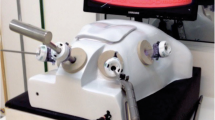Abstract
Background
The first step toward increasing the level of patient safety in endoscopic surgery is for all endoscopic surgeons to acquire fundamental skills, including psychomotor skills, in the preoperation stage of training. The current study aimed to evaluate the effectiveness of virtual reality (VR) simulator training and box training for training the fundamental skills of endoscopic surgery.
Methods
For this study, 35 medical students at Kyushu University were divided into three groups: simulator (SIM) group (n = 20), box trainer (BOX) group (n = 20), and control group (n = 15). None of the students had any experience assisting with endoscopic surgery or any previous training for endoscopic surgery. The students in the SIM group underwent training using a VR simulator, the Procedicus MIST, 2 h per day for 2 days. The students in the BOX group underwent training using a box trainer 2 h per day for 2 days. The students in the control group watched an educational video for 30 min. The endoscopic surgical skills of all the students were evaluated before and after training with a task of suturing and knot tying using a box trainer.
Results
Although no significant differences were found between the three groups in the total time taken to complete the evaluation task before training, there were significant improvements in the SIM and BOX groups after training compared with the control group. Box training increased errors during the task, but simulator training did not.
Conclusion
The findings showed that box training and VR training have different outcomes. The authors expect that the best curriculum for their training center would involve a combination that uses the merits of both methods.





Similar content being viewed by others
References
Madan AK, Frantzides CT, Shervin N, Tebbit CL (2003) Assessment of individual hand performance in box trainers compared to virtual reality trainers. Am Surg 69:1112–1114
Kothari SN, Kaplan BJ, DeMaria EJ, Broderick TJ, Merrell RC (2002) Training in laparoscopic suturing skills using a new computer-based virtual reality simulator (MIST-VR) provides results comparable to those with an established pelvic trainer system. J Laparoendosc Adv Surg Tech A 12:167–173
Hamilton EC, Scott DJ, Fleming JB, Rege RV, Laycock R, Bergen PC, Tesfay ST, Jones DB (2002) Comparison of video trainer and virtual reality training systems on acquisition of laparoscopic skills. Surg Endosc 16:406–411
Jordan JA, Gallagher AG, McGuigan J, McClure N (2001) Virtual reality training leads to faster adaptation to the novel psychomotor restrictions encountered by laparoscopic surgeons. Surg Endosc 15:1080–1084
Grantcharov TP, Bardram L, Funch-Jensen P, Rosenberg J (2003) Learning curves and impact of previous operative experience on performance on a virtual reality simulator to test laparoscopic surgical skills. Am J Surg 185:146–149
Pearson AM, Gallagher AG, Rosser JC, Satava RM (2002) Evaluation of structured and quantitative training methods for teaching intracorporeal knot tying. Surg Endosc 16:130–137
Grantcharov TP, Kristiansen VB, Bendix J, Bardram L, Rosenberg J, Funch-Jensen P (2004) Randomized clinical trial of virtual reality simulation for laparoscopic skills training. Br J Surg 91:146–150
Munz Y, Kumar BD, Moorthy K, Bann S, Darzi A (2004) Laparoscopic virtual reality and box trainers: is one superior to the other? Surg Endosc. 18:485–494
Champion JK, Hunter J, Trus T, Laycock W (1996) Teaching basic video skills as an aid in laparoscopic suturing. Surg Endosc 10:23–25
Cuschieri A, Szabo Z (1995) Chapter 4; Intracorporeal knots in endoscopic surgery. In: Cuschieri A, Szabo Z (eds) Tissue approximation in endoscopic surgery (chapter 4). ISIS Medical Media, Oxford pp 42–67
Szabo Z, Hunter J, Berci G, Sackier J, Cuschieri A (1994) Analysis of surgical movements during suturing in laparoscopy. Endosc Surg Allied Technol 2:55–61
Larsson A (2001) Intracorporeal suturing and knot tying in surgical simulation. Stud Health Technol Inform 81:2662–2671
Nguyen NT, Mayer KL, Bold RJ, Larson M, Foster S, Ho HS, Wolfe BM (2000) Laparoscopic suturing evaluation among surgical residents. J Surg Res 93:133–136
Bermas H, Fenoglio M, Haun W, Moore JT (2004) Laparoscopic suturing and knot tying: a comparison of standard techniques to a mechanical assist device. JSLS 8:187–189
Gallagher AG, Lederman AB, McGlade K, Satava RM, Smith CD (2004) Discriminative validity of the Minimally Invasive Surgical Trainer in Virtual Reality (MIST-VR) using criteria levels based on expert performance. Surg Endosc 18:660–665
Ström P, Kjellin A, Johnson E, Wredmark T, Felländer-Tsai L (2003) Validation and learning in the Procedicus KSA virtual reality surgical simulator. Surg Endosc 17:227–231
Author information
Authors and Affiliations
Corresponding author
Rights and permissions
About this article
Cite this article
Tanoue, K., Ieiri, S., Konishi, K. et al. Effectiveness of endoscopic surgery training for medical students using a virtual reality simulator versus a box trainer: a randomized controlled trial. Surg Endosc 22, 985–990 (2008). https://doi.org/10.1007/s00464-007-9554-8
Received:
Accepted:
Published:
Issue Date:
DOI: https://doi.org/10.1007/s00464-007-9554-8




